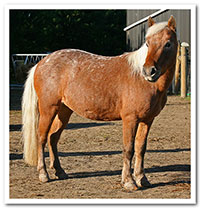Laminitis - a Ticking Clock...
Click on the image for a bigger version...
How to STOP the Laminitic Clock!
35 – Increase Exercise
30 – Move the horse to a Dry Lot (Make an Emergency one from old carpet)
25 – Take steps to drastically lower sugar & potassium intake (soak hay, no grains,
Lucerne, clover, rye-grass, soy or molasses)
20 – Double-bag the hay in small mesh Hay-Savers
15 – Ensure soft-footing, (see below)
10 – Ice the hooves and call your vet for assessment, X-Rays & pain relief
5 – You will need time off work as your horse now needs intensive care
What else we do to keep them comfortable:
The principle of reversing the clock involves addressing mineral balances AS WELL AS sugar intake. When the crest goes hard it has filled up with FLUID (ie become TURGID). The digital cushion is made of the same tissue as the crest of the neck! Fluid volumes in various body compartments are regulated by the balances of sodium, potassium & chloride, hence the emphasis to address these imbalances as a priority along with reducing sugar & carbohydrate intake.
Give a minimal feed of dampened chaff (non-lucerne) with linseed oil, am & pm with SALT (at a rate of 10gms per 100 kgs live-weight, split over 2 feeds) & Premium Minerals or Premium MVA
(Supreme Vit&Min Australia) to supply all necessary Minerals, Vitamins and Amino Acids to maintain health whilst on a strict feeding regime.
Add a tablespoon each of GrazeEzy & AlleviateC SOS to small feed multiple times per day. The bigger the horse the more times per day (8 – 10). Do this until sound. If there is no improvement within 2-3 days then you need to investigate your hay! Review by contacting us info@calmhealthyhorses.com

We do not feed beet or any other processed feeds. They are all too high in digestibility for acute cases.
Provide serious pain relief when necessary according to veterinary advice (Bute or stronger). If possible have X-Rays taken to determine the degree of rotation of the pedal bone so that you know exactly what you are dealing with.
Re hay: It is vital there is NO RYE or CLOVER and that the hay hasn’t come off heavily fertilised ground. You have to be ‘spartan’ by making it harder for them to access the hay without actually running out. Weigh the hay and soak it for an hour prior to feeding. Quantities matter!
Make sure water is available right there, they may be too sore to walk anywhere!
A yard with pea-gravel is ideal to house them on and most importantly it acts to support the bone column. They need a SOFT surface. Boots will help keep them comfortable. Wet mud is also good as is standing them in cold water containing Epsom salts for 10-15 minutes.
Time Frames – these vary from spectacular (less than 24 hours) to several weeks. Absolutely don’t feel sorry for them and put them back out on the grass! This can be a death sentence!
Regarding the trimming of a laminitic horse or pony it should be done on a case by case basis, according to the severity of the episode. Certainly no hard trims, they are sore enough already!
Only commence exercise once they are comfortable (pain-free).
NB “The Committee of THEY” can be ill-informed, stick to the plan!
Keep us posted!
 Calm Healthy Horses
Calm Healthy Horses
